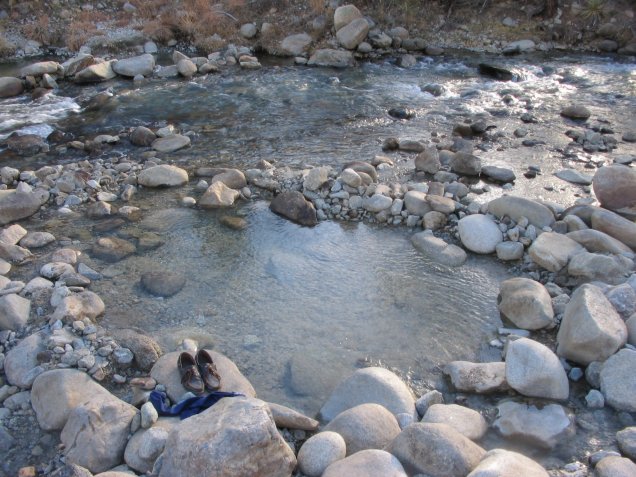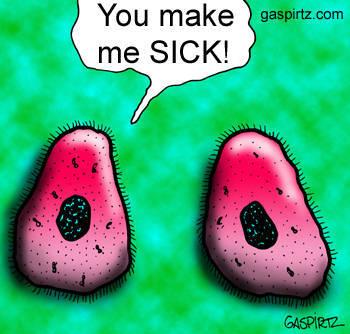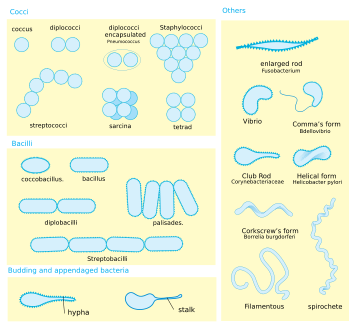Mycobacterium leprae
What are bacteria?
In biology,
organisms are first classified into 3 basic domains:
• Bacteria, which are
prokaryotic
and considered to be the "true" bacteria
• Archea, which are also
prokaryotic and sometimes called archeabacteria.
• Eukarya, which are the
eukaryotic organisms.
We are talking about
bacteria, which are prokaryotic. Prokaryotes differ from eukaryotes in several
different ways. Here are the basics:
Prokaryotes vs. Eukaryotes
• Prokaryotes, unlike the eukaryotes,
do not have a nucleus or other membrane-bound organelles.
• Their chromosomes differ in that
prokaryotes have single, circular chromosomes and eukaryotes
have multiple, linear chromosomes. Because of this, prokaryotes
are typically unicellular.
• Prokaryotes use binary fission during cell
division instead of exact mitosis.
• Prokaryotes always go through
asexual reproduction, while eukaryotes often go through sexual
reproduction as well.
• The flagella in prokaryotes
are
simple, usually having 1 flagellum that puts around.
• The cell walls of prokaryotes and
eukaryotes differ greatly. Eukaryotes have several different
types depending on the kingdom. Bacteria, in this case, have
cell walls of peptidoglycan.
• The ribosomes of prokaryotes are
much smaller, with a sedimentation rate of 70, while
eukaryotes have a sedimentation rate of 80. Eukaryotes are
usually 10 times the size of prokaryotes.
• In terms of metabolic diversity, prokaryotes are much more diverse. They can undergo various different processes and be considered into several categories such as autotrophs, chemoheterotrophs, etc. Eukaryotes, can not go through these processes.
Bacteria are EXTREMELY diverse. While only around 5,000 species have been discovered, there are probably millions existing. They are also hugely abundant. You may not have known that 90% of the human body is made up of bacterial cells.
Habitats
Bacteria sure are interesting organisms. One of the coolest qualities about them is the fact that they are extremeophiles. Extremeophiles are known for their abilities to live in extreme places that most organisms cannot survive in. Bacteria can be found in places all over the world, from the tundra to the hot springs, water with very high salinity, on the top of the mountains with high atmospheric pressure, and more. They are pretty much everywhere you can think of!
They even live inside of you. There are millions of bacteria in your mouth alone at this very moment. Because they are able to live in such diverse places, it is easily to see how they can become so abundant.
Because bacteria do live in such extreme places, they live with several different kinds of organisms and are very diverse. They can live with animals (take a human, for example, have a symbiotic relationship;) fungi (many bacteria help aid in decomposition,) plants (some bacteria such as Rhizobium help aid in nitrogen fixation in the nodules of the plants' roots,) and more. Bacteria are truly everywhere and can live with almost any kind of organism.
Lifestyle
Bacteria are diverse and have a variety of lifestyles. The most common tends to be that of bacteria and animals, such as those that live inside the human body, and these are called normal flora. These bacteria have a symbiotic relationship with the animals.
Symbiosis means "life together," meaning two or organisms that live in association with each other. There are three main types of symbiotic relationships, called mutualism, commensalism, and parasitism.
Bacteria can be mutualists, which means both members of the association are benefiting in some way. A good example of this is the bacteria found in your digestive tract. Your body needs this bacteria to aid in digestion, and the bacteria are living in a stable environment with constant temperature and nutrients.
Bacteria can also be commensals. In a commensalism relationship, neither organism benefits or is harmed. Most of the time bacteria are either mutualists or parasites, however there are some considered to be commensals. The bacteria that live on the external surfaces of the body, such as those that live on the skin, are thought to be commensals. It's often difficult to classify commensals. This happens because most scientists find that if you look at an organisms long enough, you can usually find some way that it is benefitting or being harmed.
Bacteria can also be parasites. A parasitism is when one organism is benefitting, and the other is being harmed. If the host acquires a disease due to the harm of the bacteria, the bacteria are known as pathogenic, or "disease causing." Bacteria are known to cause some of the most serious diseases in human history, including Tuberculosis (mycobacterium tuberculosis,) the Bubonic Plague (Yersinia pestis,) many STD's, and more. They also cause a lot of distress to other organisms. Bacteria are known to have caused several serious plant diseases such as Apple Fire Blight (Erwinia amylovora,) Crown Gall (Agrobacterium tumifaciens,) and more.
Morphology
General Shapes
Cocci (spherical)
Bacilli (rod-shaped)
Spirochaete (rod-shaped, tightly coiled)
Filamentous (elongated)
...and several others!
Bacteria can have several different types of morphologies, which are the shapes and sizes of the cells. As you can see in the above picture, they range from small spherical shapes called the cocci, to longer rod shapes called the bacilli, all the way to some strange stringy shapes like the spirochete and the filamentous. It's found, however, that the majority of bacteria are either cocci or bacilli. Even though it may look like there are several cells put together in a few of them, almost all bacteria are unicellular. Many group into pairs or chains, but they are still single celled. The shapes can change dramatically based on the cell wall and the cytoskeleton.
Now that you've learned some interesting things about bacteria, check out how they reproduce.
Want to learn about other interesting bacteria?
Check out these:





